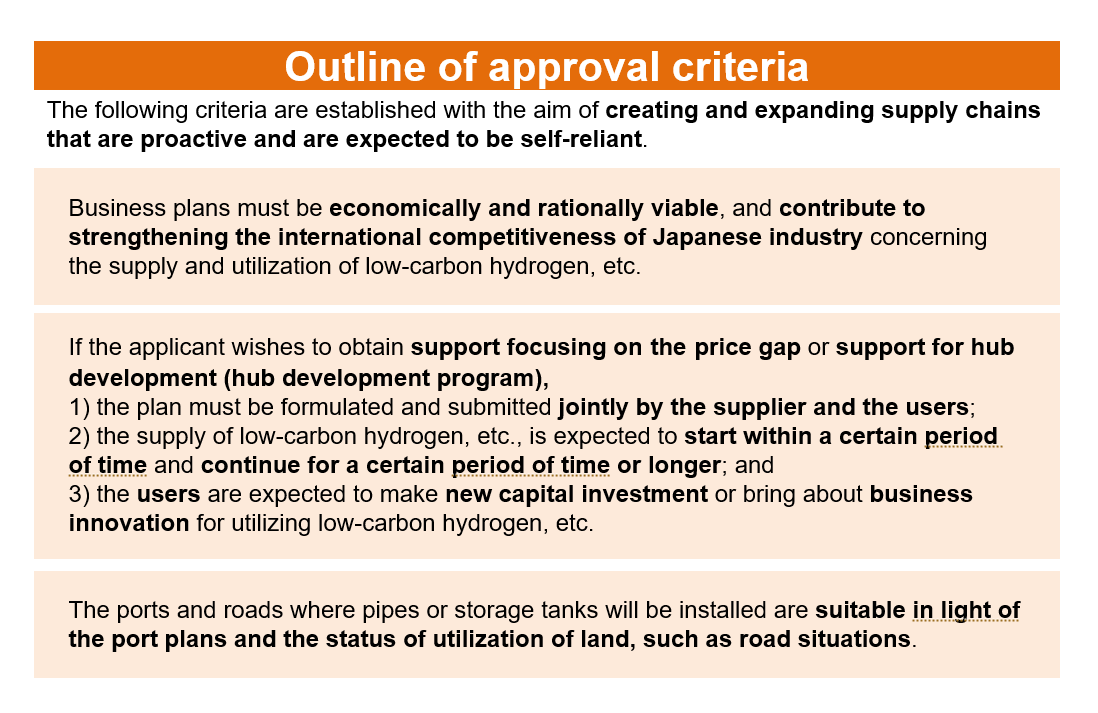Hydrogen Society Promotion Act Enacted
Toward a Forthcoming Hydrogen-based Society
Part 2: Utilization of Clean Hydrogen
(Provisional translation)
(English ver.) 2025-01-10
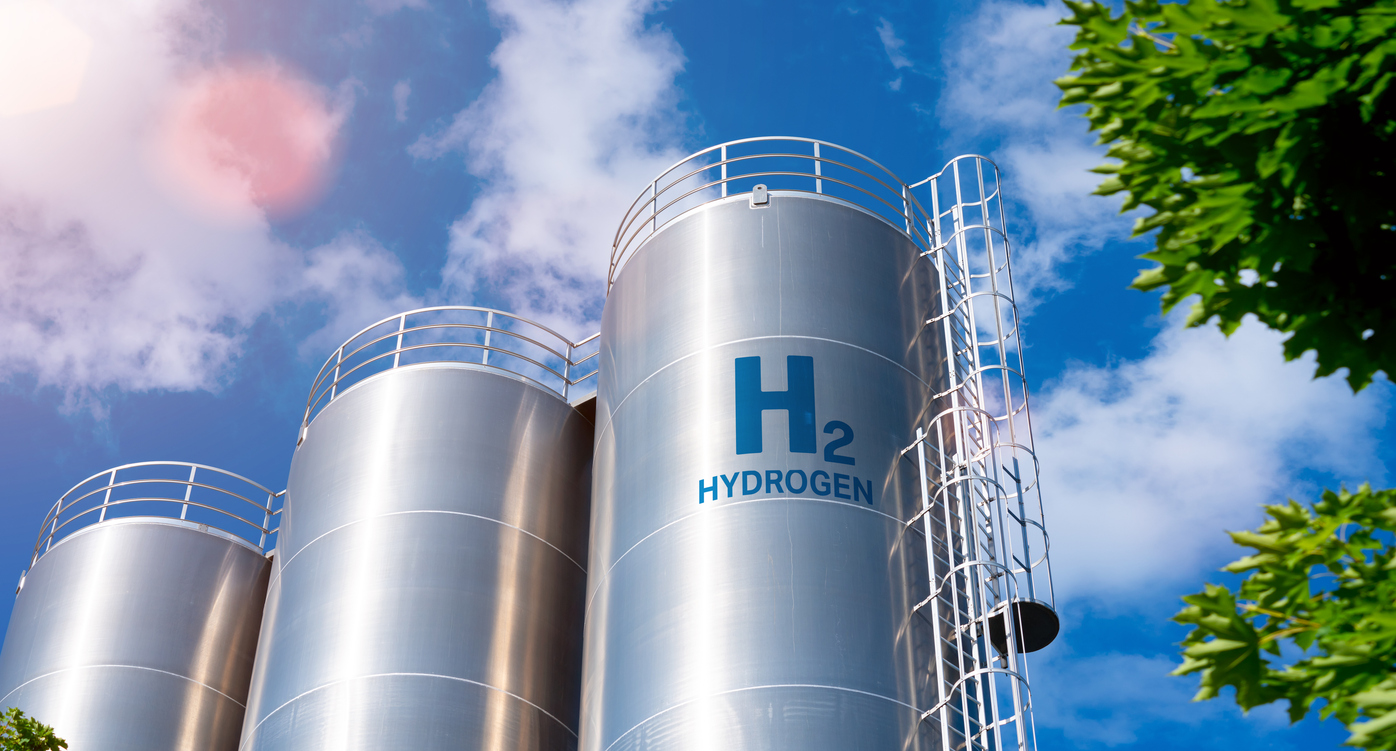
There is no doubt that decarbonizing the power generation sector is crucial toward achieving carbon neutrality by 2050. Furthermore, we are facing the challenge of advancing GX (Green Transformation) in industries that are hard to decarbonize, such as steelmaking, chemicals, and mobility. Hydrogen is a key to decarbonizing these sectors. Japan has long been conducting R&D and demonstration experiments toward the utilization of hydrogen. To ensure the widespread adoption of hydrogen in society, the Hydrogen Society Promotion Act was enacted in May 2024. Part 2 of this article here explains the aims and details of the Act.
Public support to promote the utilization of hydrogen
Emitting no CO2 during use, hydrogen can be a carbon-free source of energy, depending on how it is produced. Therefore, it has attracted attention as a next-generation source of energy.
The government is on the front lines for developing and promoting hydrogen energy. Under the GX Promotion Act* enacted in 2023, the government will issue GX Economic Transition Bonds amounting to 20 trillion yen to finance advance investments in energy transition, including support for hydrogen.
*The Act on the Promotion of Smooth Transition to a Decarbonized, Growth-Oriented Economic Structure
Following this, the Hydrogen Society Promotion Act* was enacted in May 2024 to ensure the widespread adoption of hydrogen as an energy source and promote its utilization.
*The Act on Promotion of Supply and Utilization of Low-Carbon Hydrogen and its Derivatives for Smooth Transition to a Decarbonized, Growth-Oriented Economic Structure
In the background to establishing this Act, there is the need to support businesses that undertake the utilization of hydrogen. As hydrogen is an emerging source of energy, it is expensive compared with other conventional fuels. Furthermore, to advance the large-scale utilization of hydrogen in the future, businesses must bear sizable upfront investments and operation costs. Therefore, the objective of the Act is to provide financial assistance to operators that intend to launch a hydrogen supply or utilization business after they have been scrutinized to ensure that their business plans fulfill the relevant standards.
Support focusing on the price gap between hydrogen, etc., and conventional fuels
Let us look into the details of the Hydrogen Society Promotion Act.
Promotion is aimed at the utilization of low-carbon hydrogen, etc.
The Act stipulates that it is essential to promote low-carbon hydrogen, etc., in sectors that are hard to decarbonize. However, hydrogen, etc., is not always environmentally friendly. It depends on how it is produced. Therefore, the Act is specifically targeted at low-carbon hydrogen, etc., the definition of which is described below in two criteria.
1) The amount of CO2 emitted during production is less than a certain level
The amount of CO2 here is defined as the amount of CO2 emitted during the production of one unit of hydrogen, which is referred to as carbon intensity.
Carbon intensity is a new concept specified in the outcome document of the G7 Climate, Energy and Environment Ministers’ Meeting held in Sapporo in 2023. Hydrogen has so far been classified into such categories as gray hydrogen, blue hydrogen, and green hydrogen.
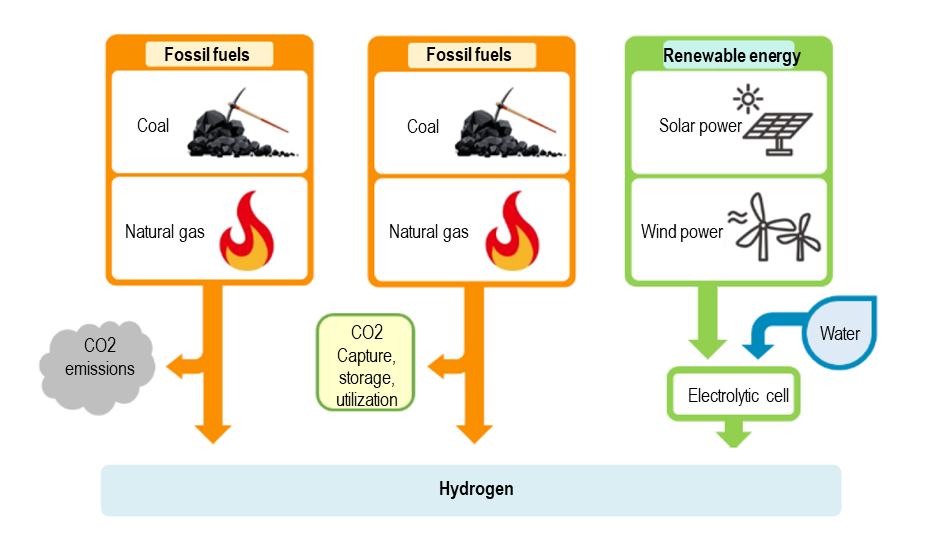
However, it is difficult to gauge how much CO2 is emitted by each of these categories. Therefore, international discussions are underway to assess the burden on the environment imposed by hydrogen, etc., by numerical analysis of CO2 emissions based on carbon intensity.
International standards are being developed using internationally recognized calculation methods. A certification scheme, which allows for mutual certification for cross-border hydrogen transactions between countries and areas, is also being built. These initiatives are expected to activate international supply chains.
In the meantime, standard figures under the Hydrogen Society Promotion Act need to be established based on the characteristics of each fuel, as the production processes differ among the various fuels. These figures will be set in line with international levels such as numbers adopted by the USA and European countries, which advocate an approximate 70% reduction from gray hydrogen produced from fossil fuels.
2) Its utilization contributes to the reduction of CO2 emissions in Japan in light of international decisions on the calculation of CO2 emissions
The Act covers not only hydrogen but also other fuels, such as ammonia, e-fuels, and e-methane, which are considered promising as next-generation fuels toward decarbonization. E-fuels and e-methane, which utilize CO2, may contribute to CO2 reduction to a certain extent. However, as they emit CO2 during combustion, it is necessary to verify that their utilization contributes to the reduction of CO2 emissions in Japan in light of international decisions on the calculation of CO2 emissions.
Businesses prepare business plans and submit them for approval
Businesses that plan to supply low-carbon hydrogen, etc., by producing it in Japan or importing it will prepare business plans jointly with businesses that plan to use it. If their business plans are examined and approved by the minister in charge, they are eligible to receive public support for 15 years from the commencement of supply, while they are under the obligation to supply for further ten years from the termination of the support. As long-term public support is given, business plans must be economically and rationally viable. Furthermore, public support will only be given if the supply of low-carbon hydrogen, etc., is expected to start within a certain period of time and continue for a certain period of time or longer. The approval criteria are outlined below:
Support measures for approved businesses
Subsidies will be granted by JOGMEC (Japan Organization for Metals and Energy Security) to approved businesses concerning the support focusing on the price gap or hub development program.
The support focusing on the price gap will be provided with the price gap between hydrogen, etc., and conventional fuels taken into account. As mentioned earlier, the cost of low-carbon hydrogen is still high, and the gap between the prices of hydrogen and conventional fuels is huge. Therefore, subsidies will be targeted at the cost related to the domestic production of hydrogen, etc., or the cost related to overseas production and maritime transportation.
The hub development program is targeted at infrastructure development, including tanks and pipelines to be built for the transportation and storage of hydrogen, etc. Subsidies will be granted for these projects.
The scope of the support focusing on the price gap and hub development program
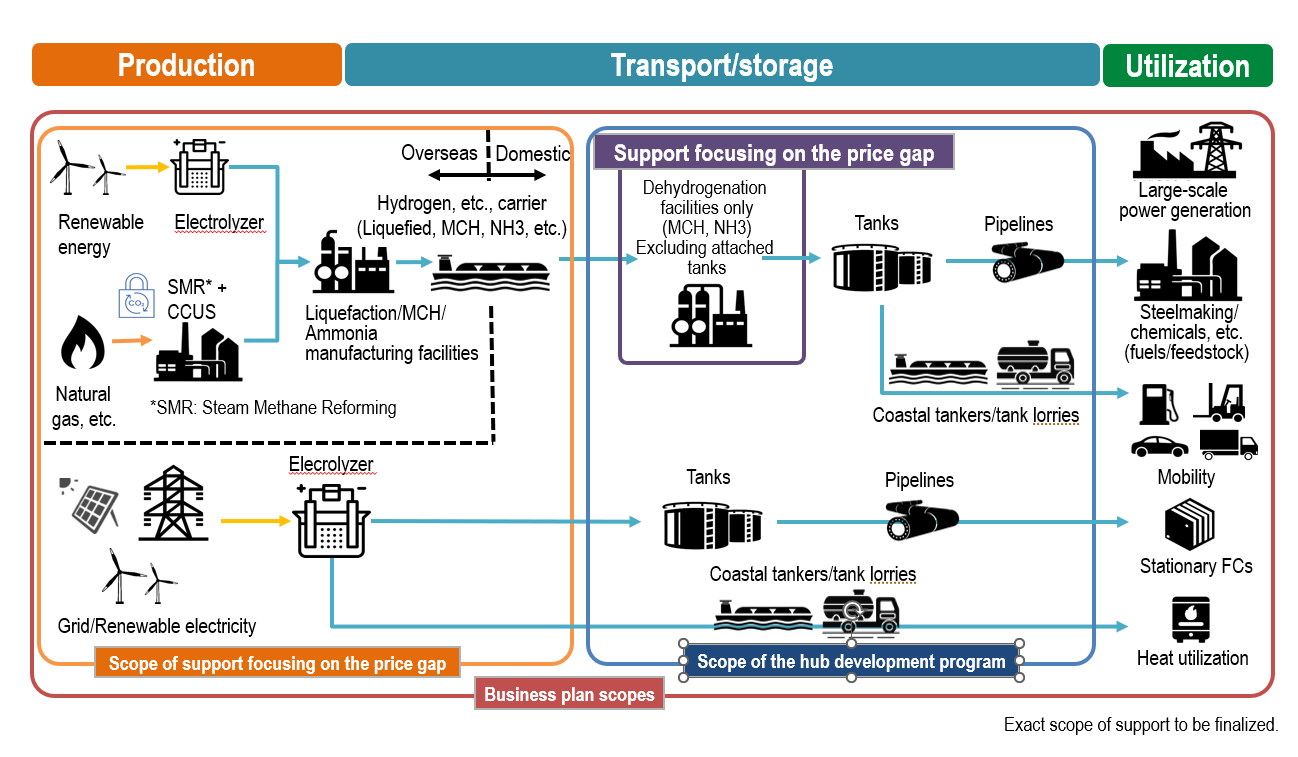
To expedite approval procedures, a one-stop service will be provided if several permits are sought under different laws, such as the Port and Harbor Act and road occupation regulations. Additionally, special provisions under the High Pressure Gas Safety Act have been established whereby the national government, on behalf of prefectural governors for a certain period of time, can conduct integrated management of granting permits and carrying out inspections on facilities based on the approved business plans.
Standards that suppliers should strive to meet
Hydrogen, etc., should ideally be carbon-free during the manufacturing process. However, green hydrogen can only be produced in small quantities at this point in time, with fossil fuel-based hydrogen having a dominant share. To increase lower-carbon hydrogen, standards that businesses engaging in the supply of hydrogen, etc., should strive to meet have been established, with the aim of encouraging them to take voluntary initiatives.
Countries around the world are introducing support systems focusing on the price gap
Hydrogen is attracting global attention, as an international research institute expects that global demand for hydrogen will rise fivefold from 2022 to 2050. Major countries have formulated support and regulatory systems for hydrogen. In recent years, these countries have been shifting the focus of their support from technical development to public implementation.
For instance, the Inflation Reduction Act (IRA) of the USA offers clean energy tax credits, including incentives for hydrogen, with a maximum tax credit of $3 per kilogram of hydrogen if it is produced domestically. The UK and Germany have established what is called the Contracts for Difference (CfD) scheme. This scheme provides long-term support for the utilization of hydrogen and ammonia, which are more expensive than conventional fuels, such as natural gas and coal, taking into account the cost differences. Japan’s support system under the Hydrogen Society Promotion Act refers to the systems of the UK and Germany.
Support and regulatory systems of major countries
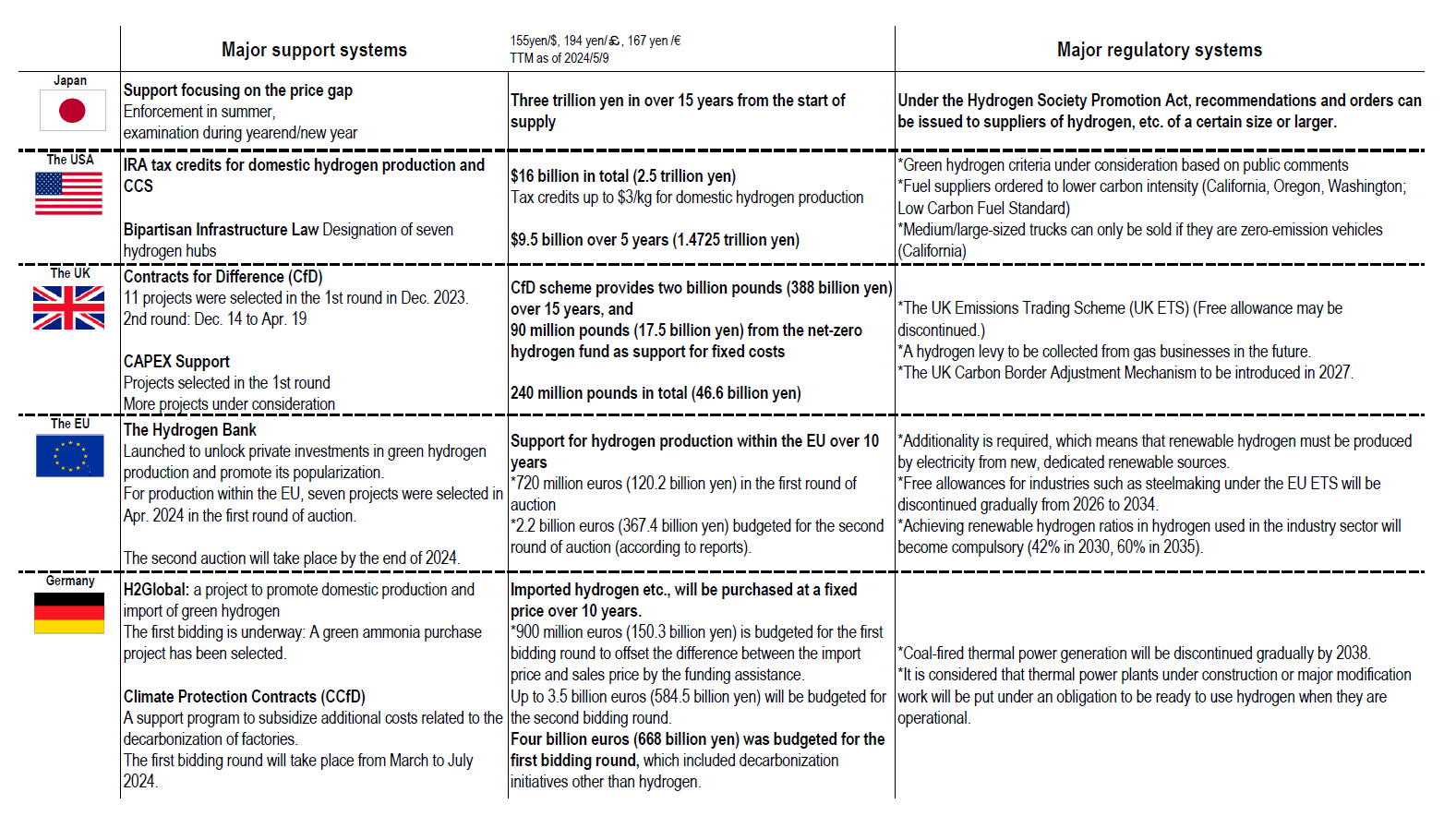
It is expected that the Hydrogen Society Promotion Act will activate businesses utilizing hydrogen, etc., and we are endeavoring toward an early enforcement of the Act.
Divisions in Charge
About this article
Hydrogen and Ammonia Division, Energy Efficiency and Renewable Energy Department, ANRE
About the Special Contents
Research and Public Relations Office, Commissioner’s Secretariat, ANRE
![]() The original Japanese text of this article; Click here
The original Japanese text of this article; Click here
